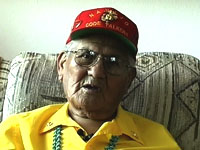|
"People ask me, 'Why did you go? Look at all the mistreatment that has been done to your people.' Somebody’s got to go, somebody’s got defend this country. Somebody’s got to defend the freedom. This is the reason why I went." (Video Interview, 1:13:33)
|
|
{
align: 'left'
}
|
Chester Nez |

Chester Nez [2003] | World War, 1939-1945; Korean War, 1950-1953
Marine Corps
1st Marine Division; 3rd Marine Division
Guadalcanal and Bougainville (Solomon Islands); Guam (Mariana Islands); Peleliu Island (Palau); Pacific Theater; also: Korea
Corporal
AZ
 |
|
 |
During World War II, Marine recruiters came to a high school in Tuba City, Arizona, in search of Navajos to participate in a secret program. Chester Nez was one of the young men who volunteered, and he passed through rigorous training and testing to become one of the Code Talkers, who used their native language to confound Japanese who were intercepting American communications. Nez outlines in detail how 29 young recruits assembled a complex code that helped win the war. He recalls being mistaken for the enemy and having a gun held to his head by an overeager soldier.
|
|

